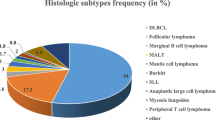Abstract
The relative frequency of the non-Hodgkin lymphoma (NHL) subtypes varies around the world. The objective of this study was to describe the general features of patients with lymphoma in Colombia. A total of 819 patients with a new diagnosis of lymphoma were included. Nighty-nine (12 %) of them had Hodgkin lymphoma (HL) and 720 (88 %) had NHL. Most cases had advanced stage disease at presentation (63.6 %). Diffuse large B cell lymphoma (DLBCL) was the most frequent diagnosis; it was seen in 40 % of patients with NHL and in 35 % of patients in the whole series. Overall survival rates at 3 years were 77 % for HL and follicular lymphoma, 54 % for DLBCL, and 45 % for T cell lymphomas. In conclusion, the distribution of specific NHL subtypes is similar to what has been reported previously in other tropical countries.



Similar content being viewed by others
References
Swerdlow SH (2008) WHO Classification of Tumours of Haematopoietic and Lymphoid Tissues. 4th edn (International Agency for Research on Cancer. World Health Organization, Lyon
Anderson JR, Armitage JO, Weisenburger DD (1998) Epidemiology of the non-Hodgkin’s lymphomas: distributions of the major subtypes differ by geographic locations. Non-Hodgkin’s Lymphoma Classification Project. Ann Oncol 9:717–720
Vose J, Armitage J (2008) Weisenburger D; International T-Cell Lymphoma Project. International peripheral T-cell and natural killer/T-cell lymphoma study: pathology findings and clinical outcomes. J Clin Oncol 26:4124–4130
Yang QP, Zhang WY, Yu JB et al (2011) Subtype distribution of lymphomas in Southwest China: analysis of 6,382 cases using WHO classification in a single institution. Diagn Pathol 6:77
Yoon SO, Suh C, Lee DH et al (2010) Distribution of lymphoid neoplasms in the Republic of Korea: analysis of 5318 cases according to the World Health Organization classification. Am J Hematol 85:760–764
Murillo RH, Piñeros M, Acosta JA, Castellanos VH (2012) Instituto Nacional de Cancerología Anuario Estadístico 2010. Volumen 8 (Instituto Nacional de Cancerología: Bogotá, Colombia)
Cheson BD, Pfistner B, Juweid ME (2007) Revised response criteria for malignant lymphoma. J Clin Oncol 25:579–86
Parkin DM (2006) The evolution of the population-based cancer registry. Nat Rev Cancer 6:603–612
Townsend W, Linch D (2012) Hodgkin's lymphoma in adults. Lancet 380:836–847
Roman E, Smith AG (2011) Epidemiology of lymphomas. Histopathology 58:4–14
Shankland KR, Armitage JO, Hancock BW (2012) Non-Hodgkin lymphoma. Lancet 380:848–857
Novelli S, Briones J, Sierra J (2013) Epidemiology of lymphoid malignancies: last decade update. Springerplus 2:70
Luminari S, Cesaretti M, Rashid I et al (2007) Incidence, clinical characteristics and survival of malignant lymphomas: a population based study from cancer registry in northern Italy. Hematol Oncol 25:189–197
Laurini J, Perry A, Boilesen E et al (2012) Classification of non-Hodgkin lymphoma in Central and South America: a review of 1028 cases. Blood 120:4795–4801
Morton LM, Wang SS, Devesa SS, Hartge P, Weisenburger DD, Linet MS (2006) Lymphoma incidence patterns by WHO subtype in the United States, 1992-2001. Blood 107:265–76
Montoto S, Fitzgibbon J (2011) Transformation of Indolent B-Cell Lymphomas. J Clin Oncol 29:1827–34
Perry AM, Molina-Kirsch KH, Nathwani BN et al (2011) Classification of non-Hodgkin lymphomas in Guatemala according to the World Health Organization system. Leuk Lymphoma 52:1681–1688
Morrow RH Jr (1985) Epidemiological evidence for the role of falciparum malaria in the pathogenesis of Burkitt's lymphoma. IARC Sci Publ 60:177–86
Thorley-Lawson DA, Gross A (2004) Persistence of the Epstein–Barr virus and the origins of associated lymphomas. N Engl J Med 350:1328–1337
Chene A, Donati D, Orem J et al (2009) Endemic Burkitt's lymphoma as a polymicrobial disease: new insights on the interaction between Plasmodium falciparum and Epstein-Barr virus. Semin Cancer Biol 19:411–20
Diehl V, Franklin J, Pfreundschuh M et al (2003) Standard and increased-dose BEACOPP chemotherapy compared with COPP-ABVD for advanced Hodgkin's disease. N Engl J Med 348:2386–95
Hiddemann W, Kneba M, Dreyling M et al (2005) Frontline therapy with rituximab added to the combination of cyclophosphamide, doxorubicin, vincristine, and prednisone (CHOP) significantly improves the outcome for patients with advanced-stage follicular lymphoma compared with therapy with CHOP alone: results of a prospective randomized study of the German Low-Grade Lymphoma Study Group. Blood 106:3725–32
Sehn LH, Donaldson J, Chhanabhai M et al (2005) Introduction of combined CHOP plus rituximab therapy dramatically improved outcome of diffuse large B-cell lymphoma in British Columbia. J Clin Oncol 23:5027–33
Cunningham D, Hawkes EA, Jack A et al (2013) Rituximab plus cyclophosphamide, doxorubicin, vincristine, and prednisolone in patients with newly diagnosed diffuse large B-cell non-Hodgkin lymphoma: a phase 3 comparison of dose intensification with 14-day versus 21-day cycles. Lancet 381:1817–26
Hallek M, Fischer K, Fingerle-Rowson G et al (2010) Addition of rituximab to fludarabine and cyclophosphamide in patients with chronic lymphocytic leukaemia: a randomised, open-label, phase 3 trial. Lancet 376:1164–74
Shenoy PJ, Malik N, Nooka A et al (2011) Racial differences in the presentation and outcomes of diffuse large B-cell lymphoma in the United States. Cancer 117:2530–40
Conflict of interest
The authors declare that they have no conflict of interest.
Author information
Authors and Affiliations
Corresponding author
Rights and permissions
About this article
Cite this article
Combariza, J.F., Lombana, M., Torres, A.M. et al. General features and epidemiology of lymphoma in Colombia. A multicentric study. Ann Hematol 94, 975–980 (2015). https://doi.org/10.1007/s00277-015-2301-7
Received:
Accepted:
Published:
Issue Date:
DOI: https://doi.org/10.1007/s00277-015-2301-7




